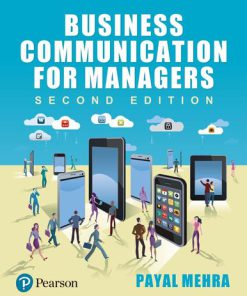Mind Tools for Managers 1st edition by Birkinshaw,Julian Birkinshaw 9781119374473 9781119374473
$50.00 Original price was: $50.00.$25.00Current price is: $25.00.
Mind Tools for Managers 1st edition by Birkinshaw,Julian Birkinshaw – Ebook PDF Instant Download/Delivery: 9781119374473,9781119374473
Full download Mind Tools for Managers 1st edition after payment
Product details:
ISBN 10:9781119374473
ISBN 13: 9781119374473
Author: Birkinshaw,Julian Birkinshaw
Mind Tools for Managers helps new and experienced leaders develop the skills they need to be more effective in everything they do. It brings together the 100 most important leadership skills–as voted for by 15,000 managers and professionals worldwide–into a single volume, providing an easy-access solutions manual for people wanting to be the best manager they can be. Each chapter details a related group of skills, providing links to additional resources as needed, plus the tools you need to put ideas into practice. Read beginning-to-end, this guide provides a crash course on the essential skills of any effective manager; used as a reference, its clear organization allows you to find the solution you need quickly and easily.
Success in a leadership position comes from results, and results come from the effective coordination of often competing needs: your organization, your client, your team, and your projects. These all demand time, attention, and energy, and keeping everything running smoothly while making the important decisions is a lot to handle. This book shows you how to manage it all, and manage it well, with practical wisdom and expert guidance.
- Build your ideal team and keep them motivated
- Make better decisions and boost your strategy game
- Manage both time and stress to get more done with less
- Master effective communication, facilitate innovation, and much more
Managers wear many hats and often operate under a tremendously diverse set of job duties. Delegation, prioritization, strategy, decision making, communication, problem solving, creativity, time management, project management and stress management are all part of your domain. Mind Tools for Managers helps you take control and get the best out of your team, your time, and yourself.
Mind Tools for Managers 1st Table of contents:
Part I: Know and Manage Yourself
Chapter 1: Know Yourself
1. Understand Your Own Personality and Manage Accordingly (The Big Five Personality Model)
2. Understand and Make Better Use of Your Personal Strengths (Personal SWOT Analysis)
3. Set Clear Personal Goals, and Show a Strong Sense of Direction (Personal Goal Setting)
4. Build Your Self-Confidence
5. Be Aware of How Your Actions Impact Others (Journaling for Self-Development)
6. Think Positively and Manage Negative Thoughts (Cognitive Restructuring)
7. Adopt a Self-Development Mindset (Dweck’s Fixed and Growth Mindsets)
Other Techniques for Knowing Yourself
Chapter 2: Plan and Manage Your Time
8. Find More Time in Your Day by Eliminating Low-Yield Activities (Activity Logs)
9. Prioritize Tasks Effectively for Yourself and Your Team (Action Priority Matrix)
10. Use a Structured Approach for Tracking and Prioritizing Many Tasks (Action Programs)
11. Schedule Your Time Effectively
12. Keep Yourself Focused: Managing Distractions, Improving Flow
13. Beat Procrastination
Other Techniques for Planning and Managing Your Time
Chapter 3: Cope with Change and Stress
14. Develop Personal Resiliency, and Grow from Setbacks
15. Analyze and Manage Sources of Stress (Stress Diaries)
16. Manage Negative Emotions at Work (The STOP Method for Anger Management)
17. Manage the Impact of Pressure on Performance (The Inverted-U Model)
18. Overcome Fears of Failure or Success
19. Learn from Your Experience in a Systematic Way (Gibbs’s Reflective Cycle)
Other Techniques for Coping with Change and Stress
Chapter 4: Manage Your Career over Time
20. Find a Career That Suits Who You Are (Ibarra’s Identify Transition Process)
21. Find a Role That Provides Meaning and Pleasure and Fully Uses Your Strengths (The MPS Process)
22. Shape Your Role to Suit Your Strengths and Aspirations (Job Crafting)
23. Thrive at Work (The GREAT DREAM Model)
24. Find the Work–Life Balance That’s Best for You (The Wheel of Life®)
25. Understand the Types of Behavior That Can Derail Your Career (Hogan Management Derailment)
Other Techniques for Managing Your Career
Part II: Manage Tasks, and Get Things Done
Chapter 5: Get Work Done in an Efficient and Focused Way
26. Translate the Organization’s Mission into Goals That People Understand (OGSM)
27. Align People’s Objectives with Corporate Goals (OKRs)
28. Systematically Analyze and Optimize the Work Team Members Do (DILO)
29. Use a Structured Approach to Continuous Improvement (PDSA)
30. Systematically Identify What Needs to Be Done – Gap Analysis
31. Conduct Post-Completion Project Reviews (Retrospectives)
32. Manage Projects Using Agile Methodologies (Agile Project Management)
Chapter 6: Solve Problems Effectively
33. Get Systematically to the Root of a Problem (Root Cause Analysis)
34. Identify the Many Possible Causes of a Problem (Cause and Effect Analysis)
35. Map Business Processes Clearly (Swim Lane Diagrams)
36. Solve Problems by Capitalizing on What’s Going Well (The 5-D Approach to Appreciative Inquiry)
37. Bring People Together to Solve Problems (Manage Group Dynamics)
Other Useful Problem-Solving Techniques
Chapter 7: Make Smart Decisions
38. Decide Whether a Decision Makes Financial Sense (Net Present Value Analysis)
39. Choose Between Options and Considering Multiple Factors (Decision Matrix Analysis)
40. Consider Many Factors, Such as Opportunities, Risks, Reactions, and Ethics in Decision Making (ORAPAPA)
41. Analyze Systematically What Could Go Wrong (Risk Analysis and Risk Management)
42. Prioritize Risks by Impact and Probability of Occurrence (The Risk Impact/Probability Chart)
43. Avoid Psychological Bias in Decision Making
Other Useful Decision-Making Techniques
Chapter 8: Foster Creativity and Innovation
44. Develop New Ideas by Understanding User Needs (Design Thinking)
45. Innovate by Studying People’s Day-to-Day Use of Products and Services in Depth (Ethnographic Research)
46. Innovate by Making Sense of How the Business World Is Changing (Scenario Planning)
47. Innovate in All Areas of Your Business, Not Just with Products and Services (Doblin’s 10 Types of Innovation)
48. Generate Many Ideas Using Free Association (Brainstorming)
Other Techniques for Fostering Creativity and Innovation
Part III: Work with and Manage Other People
Chapter 9: Understand and Motivate Other People
49. Lead by Example (Being a Good Role Model)
50. Listen Carefully and Intensely to Other People (Mindful Listening)
51. Understand How to Motivate People (Herzberg’s Motivation-Hygiene Theory)
52. Work Effectively with People from Different Generations (Understand Different Generational Characteristics)
53. Develop Emotional Intelligence
54. Motivate People to Go above and beyond (Transformational Leadership)
Other Techniques for Understanding and Motivating Other People
Chapter 10: Get the Best from Members of Your Team
55. Delegate Effectively
56. Be Clear About Who Is Accountable for What (The RACI Matrix)
57. Give Effective Praise and Recognition
58. Build Team Members’ Self-Confidence
59. Support Your People Effectively (Heron’s Six Categories of Intervention)
Other Ways to Get the Best from Members of Your Team
Chapter 11: Communicate Effectively
60. Understand the Key Principles of Good Communication (The Seven Cs of Communication)
61. Speak Well in Public
62. Write Effective E-Mails
63. Build Good Working Relationships with People at All Levels (Create “High-Quality Connections”)
64. Communicate Effectively Across Cultures (Hofstede’s Cultural Dimensions)
Other Techniques for Communicating Effectively
Chapter 12: Hire and Develop Good People
65. Design Jobs Effectively (Motivation-Centered Job Descriptions)
66. Recruit Effectively (Competency-Based Interviewing)
67. Assess Individual Development Needs (Skills Matrices)
68. Give Effective Feedback (The SBI Feedback Model)
69. Coach People Effectively (The GROW Model)
Chapter 13: Build a Great Team
70. Formally Define the Team’s Mission, Authority, Resources, and Boundaries (Team Charters)
71. Brief Your Team Clearly
72. Build Trust in Your Team
73. Build Openness and Self-Knowledge within a Team (The Johari Window)
74. Find the Specific Motivators That Work Best with Your Team (Understand Team-Specific Motivation)
75. Manage Negative Behaviors and Resolve Conflict (Lencioni’s Five Dysfunctions of a Team)
Chapter 14: Deal with Difficult Management Situations Effectively
76. Resolve Conflict Effectively (Fisher and Ury’s Principled Negotiation)
77. Deal with Bad Behavior at Work
78. Deal with Office Politics, and Protect Your Team from Them
79. Handle Poor Performance
80. Be Tactful
Part IV: General Commercial Awareness
Chapter 15: Develop Situational Awareness
81. Understand Your Organization’s Mission and Values (Mission Statements)
82. Scan for External Changes That May Impact Your Organization (PESTLIED Analysis)
83. Understand How Companies Compete in Your Market (Value Curves)
84. Understand Your Organization’s Core Competencies
85. Organizational Strengths, Weaknesses, Opportunities, and Threats (SWOT Analysis)
Chapter 16: Get Ahead in the Wider Organization
86. Understand and Shape How Others in Your Organization See You (The PVI Model)
87. Ask for Feedback (The SKS Technique)
88. Build Honest Rapport with Others
89. Develop Effective Networking Skills
90. Influence Your Peers to Get Things Done (Yukl and Tracey’s Influencers)
Chapter 17: Make Change Happen in Your Organization
91. Understand Stakeholder Needs, and Bring Stakeholders Along with You (Stakeholder Management and Power/Interest Grids)
92. Understand the Key Steps Needed to Succeed with a Change Process (Kotter’s Eight-Step Change Model)
93. Anticipate and Manage People’s Emotional Reactions to Change (The Change Curve)
94. Persuade and Influence People Effectively (The Influence Model)
95. Lead Change Without Formal Authority (“Stealth Innovation”)
Chapter 18: Work Effectively with Customers and External Stakeholders
96. Understand Your Customer’s Worldview (Develop Customer Personas)
97. Understand and Develop Your Relationship with Your Customer (Customer Experience Mapping)
98. Understand How Decisions Are Made in Another Organization (Influence Mapping)
99. Decide the Best Approach to a Negotiation (Lewicki and Hiam’s Negotiation Matrix)
100. Collaborate to Create Mutually Beneficial Outcomes (Win-Win Negotiation)
People also search for Mind Tools for Managers 1st :
organizational tools for managers
orkin branch manager reviews
organizational mindset
mind tools leadership assessment
one minute manager tools
Tags:
Birkinshaw,Julian Birkinshaw,Tools,Managers,Mind
You may also like…
Uncategorized
Financial Accounting For Managers 3rd Edition by Sanjay Dhamija 9352868331 9789352868339
Business & Economics - Management & Leadership
Financial Accounting For Managers 3rd Edition Sanjay Dhamija
Engineering
Lean Six Sigma and statistical tools for engineers and engineering managers First Edition Ding
Business & Economics - Management & Leadership
Business & Economics - Others
Essential Statistics for Public Managers and Policy Analysts Wang
Business & Economics - Accounting













